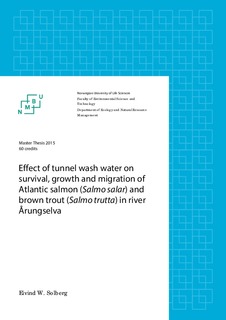| dc.contributor.author | Solberg, Eivind Wollert | |
| dc.date.accessioned | 2016-04-05T11:40:33Z | |
| dc.date.available | 2016-04-05T11:40:33Z | |
| dc.date.issued | 2016-04-05 | |
| dc.identifier.uri | http://hdl.handle.net/11250/2384007 | |
| dc.description.abstract | Tunnel wash water is frequently released to the river Årungselva through a sedimentation pond.
This tunnel wash water may cause harm to the fish through intrinsic and extrinsic toxic effects.
A reduction in growth have previously been observed for 0+ brown trout at downstream
locations of the sedimentation pond, where fish located below outlet point of the sedimentation
pond had a 21 % lower length than fish located above the sedimentation pond. As no reduction
in growth were observed prior to the establishment of the sedimentation pond, the author
suggested that the reduced growth could be due to the toxic effect from the tunnel wash water.
Since migration and density was not accounted for, it remains enigmatic whether the observed
difference was solely due to the suggested toxic effect.
The aim of this study was to estimate differences in survival, growth and migration of Atlantic
salmon (Salmo salar) and brown trout (Salmo trutta) caught above and below the outlet point
of the Vassum sedimentation pond in Årungselva.
The study was conducted using capture-mark-recapture methodology in combination with
Passive Integrated Transponders (PIT) telemetry with two antennas. This set-up allowed for
estimation of survival, individual growth and migration.
In total, 520 individuals were caught by electric fishing. Out of these, 253 individuals were PITtagged
from which 75 were resighted at least once during the November 2014-October 2015
study period. The results show a lower size-adjusted survival in both species for individuals
caught below the outlet point compared to those caught above the outlet point. Further, a lower
length-at age among 0+ parr of brown trout and 1+ parr of Atlantic salmon, as well as lower
length at first-winter for Atlantic salmon parr, were observed for below-individuals compared
to above-individuals.
The reduced survival and growth rate observed in this study occur despite the fact that fish
density is lower at below-sites of the outlet point of the sedimentation pond. Water chemistry
variables generally did not vary between above and below sites, apart from chloride, sulphate
and uranium that all attained higher below-values. However, other physiochemical variables
that vary between above and below outlet point sites may influence growth and survival. In
conclusion, fish at below-sites of the outlet point may experience a higher exposure to pollution
due to the release of tunnel wash water based on these results. | nb_NO |
| dc.language.iso | eng | nb_NO |
| dc.publisher | Norwegian University of Life Sciences, Ås | |
| dc.rights | Navngivelse-Ikkekommersiell-IngenBearbeidelse 3.0 Norge | * |
| dc.rights.uri | http://creativecommons.org/licenses/by-nc-nd/3.0/no/ | * |
| dc.title | Effect of Tunnel Wash Water on Survival, Growth and Migration of Atlantic Salmon (Salmo salar) and Brown Trout (Salmo Salar) in River Årungselva | nb_NO |
| dc.type | Master thesis | nb_NO |
| dc.subject.nsi | VDP::Agriculture and fishery disciplines: 900::Fisheries science: 920 | nb_NO |
| dc.subject.nsi | VDP::Mathematics and natural science: 400::Zoology and botany: 480::Ecology: 488 | nb_NO |
| dc.source.pagenumber | 87 | nb_NO |
| dc.description.localcode | M-ECOL | nb_NO |

